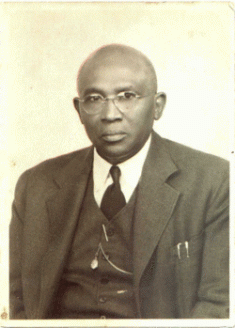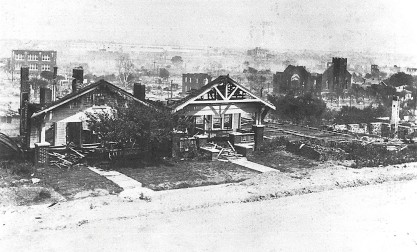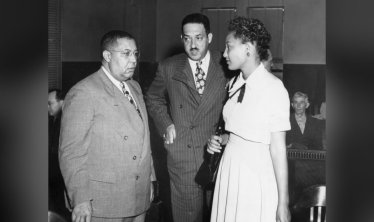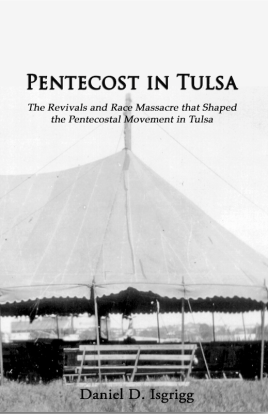During my research on the history of the Pentecostal movement in Tulsa, I discovered the story of a Church of God in Christ pastor, Bishop Travis B. Sipuel, who survived the 1921 Tulsa Race Massacre. His story we know because of his daughter Ada Lois Sipuel Fisher, the famous Oklahoma Civil Rights leader. This is his story.

Bishop Travis B. Sipuel (1877-1946)
In 1917, Elder E. M. Page was commissioned by Church of God in Christ founder and Senior Bishop, Charles H. Mason, to be the State Overseer for Oklahoma churches. Page moved to Oklahoma to establish a church in Muskogee and then came to Tulsa.[2] Page saw that leadership was needed for the fledgling COGIC church in Tulsa invited a young pastor from Arkansas, Bishop Travis B. Sipuel, to move to Tulsa with his wife Martha. Bishop Sipuel rented a house on North Greenwood and leased a building for the North Greenwood Church of God in Christ.[3] The building was located at 700 N. Greenwood (presently OSU Tulsa), on the North end of the thriving Black Wallstreet. Sipuel helped to grow the church to 40 people during his time there. Sipuel believed that the beautiful community of Greenwood in Tulsa was the best place to raise a family and build a church.

Home near by where the Sipuel’s may have lived.
When the horrific events of 1921 broke out May 31st, 1921. Sipuel’s family was not immune to the horrific violence. On June 1st , when the mob violence turned to Greenwood, Bishop and Martha Sipuel saw their beautiful house burned by looters. Bishop Sipuel was taken by the Tulsa militia, along with the thousands of black men hands held high, and was marched to an “concentration camp” for black residents in McNulty Park, Tulsa’s ballpark. Meanwhile, Sipuel’s wife was left to watch helplessly and alone as their beautiful house burn to the ground in front of her. One of the white militia men stopped by her as she watched and told her she “better get out of town.”[4]

Photo Credit: Tulsa Historical Society
Although everything they owned was destroyed , thankfully Bishop Sipuel and his wife survived the Race Massacre. They decided to leave town and instead settled in Chickasha, Oklahoma, where he pastored the COGIC church and eventually became a state overseer. His daughter, Ada Lois Sipuel Fisher, was born in Chickasha and decided to try to enter the University of Oklahoma Law School. When she was denied, she became a civil rights pioneer when her case went all the way to the Supreme Court. She eventually won and graduated and eventually became a law professor at Langston University. In 1992, Lois Sipuel Fisher was appointed to the OU Board of Regents and a garden was named in her honor.

Ada Sipuel with Justice Thurgood Marshall
Despite the tragedies of 1921, the Church of God in Christ and black Pentecostal community in Tulsa survived and continued to grow. Just one year later, in 1922, the North Greenwood COGIC was said to have grown to 250 people; no doubt the community had turned to the church for hope.[5] The Greenwood Community would eventually rebuild and once again became a center for black commerce in Tulsa. Bishop Travis Sipuel led an distinguished career as a COGIC pastor and leader in Oklahoma.
There are more stories to tell about the black Pentecostal church in Tulsa, which I hope can I uncover and tell. But to me, Bishop Sipuel’s story makes this event all the more real and makes me more passionate to uncover all I can about the history of the black Pentecostal church in Tulsa.
(For related research, see my post about Oral Roberts and the story of Beno Hall being reclaimed for racial reconciliation) For more on the history of Tulsa’s black Pentecostal churches, check out my book Pentecost in Tulsa.
[1] Polk Hoffine’s Directory Co.’s Tulsa City Directory (1922), 16.
[2] Church of God in Christ Yearbook, (1926), 67.
[3] Ada Lois Sipuel Fisher, Matter of Black and White (University of Oklahoma Press, 2006), 10. The Polk-Hoffhine Directory Co.’s Tulsa City Directory (1922) notes this as the second COGIC church in Tulsa, although it is hard to know how the two churches were related.
[4] Fisher, Matter of Black and White, 12.
[5] Polk Hoffine’s Directory Co.’s Tulsa City Directory, 1922, 16.

Thus is my great great grandmother sisters saugtet and her dad Travis. These are my ancestors ❤️✊🏾
Thank so much for commenting Nadine! If you come across any more information, please let me know. Ada Lois’ book was a great help to telling his story, and hers. It will be in my book on the history of the Pentecostal movement in Tulsa
Hey Daniel. What information do you need?
Thanks Nadine. If you have any additional information on thier Tulsa years, I would love to have it. They were there for 5 years at least, but The only mention is brief in Ada’s book. If you have any stories of that era, feel free to email me at pastorisgrigg@gmail.com. I am so grateful for your family.
Pingback: Ada Lois Sipuel Fisher and the Pentecostal Origins of Desegregation | Daniel D. Isgrigg
Pingback: Notable COGIC Women from the Tulsa Area | Daniel D. Isgrigg